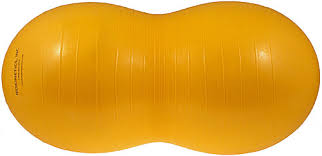According to a new study by nurse researchers at Banner Good Samaritan Medical Center, a Phoenix hospital part of Banner Health, a peanut-shaped exercise ball can be a highly effective tool to accelerate the labor process for women with an epidural. The research shows women utilizing the peanut ball were half as likely to undergo a cesarean surgery and delivered babies faster than those who did not use the ball. The results are published in the 2015 winter edition of the Journal of Perinatal Education.
“The peanut ball is a low-risk, low-cost nursing intervention that promotes positive labor outcomes and reduces the duration of the delivery process,” said Christina Tussey, MSN, RN, CNS, lead author of the study and a clinical nurse specialist at Banner Good Samaritan. “Of U.S. women who require a primary cesarean surgery, more than 90 percent will have a subsequent repeat cesarean. Women utilizing the peanut ball during labor had a statistically lower rate of needing a cesarean section for delivery thus reducing the risks associated the primary cesarean surgery and implications for subsequent pregnancies.”
Epidurals, which help relieve pain during birth, along with size and position of the fetus can prolong labor and are associated with an increased need to perform C-sections. C-sections currently account for more than 30 percent of childbirths nationwide and are often perceived as benign. However, the procedure can increase the risk of infection and hemorrhage for delivering moms while also causing damage to her abdomen and urinary tract. By undergoing a surgical procedure, women generally experience a longer recovery time, and potential complications from anesthesia, which can increase health care costs.
The ability to change a woman’s position during labor is associated with multiple benefits that include decreased labor time, increased circulation, fetal descent, and improved quality of contractions. But women who use an epidural are usually limited in the number and capacity to try different position changes during labor.
The nurse-led randomized, controlled trial conducted at the nonprofit hospital in Phoenix examined differences in groups who used the peanut ball and those who did not, including decreased length of labor and increased rate of vaginal birth. The study findings suggest that labor is enhanced by optimally positioning the fetus to increase the pelvic diameter and allow more room for fetal descent.
Women using the peanut ball had a significantly shorter labor period during the first and second stages. Additionally, 21 percent of women assigned to the control group required cesarean surgery compared to only 10 percent of women who used the peanut ball.
“Organizations have begun assuming responsibility for limiting elective procedures, especially C-sections, recognizing that the best outcomes overall for both mother and child occur in facilities with cesarean surgery rates in the 5-10% range,” said Emily Botsios, BSN, RN, an author of the study and clinical nurse at Banner Health. “Our findings show that mothers can ask for a risk-free option to help promote labor when receiving an epidural. Based on the success of the study, we have implemented use of the peanut ball in all labor and delivery units across Banner Health.”


